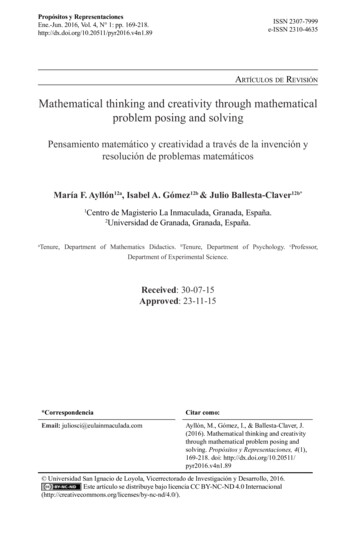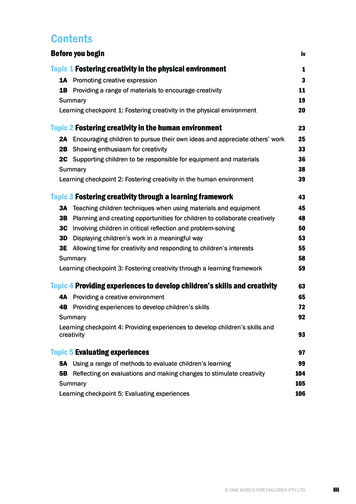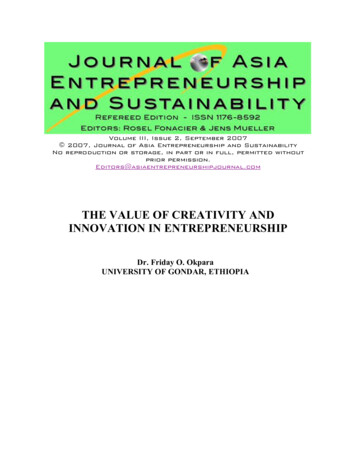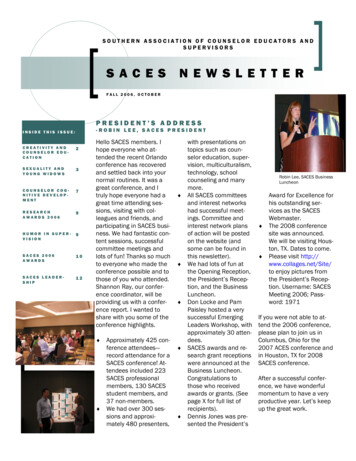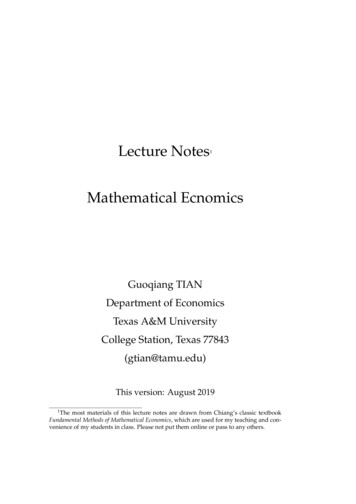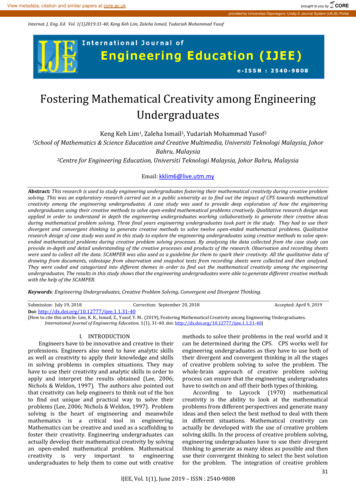
Transcription
View metadata, citation and similar papers at core.ac.ukbrought to you byCOREprovided by Universitas Diponegoro: Undip E-Journal System (UEJS) PortalInternat. J. Eng. Ed. Vol. 1(1)2019:31-40, Keng Keh Lim, Zaleha Ismail, Yudariah Mohammad YusofFostering Mathematical Creativity among EngineeringUndergraduates1SchoolKeng Keh Lim1, Zaleha Ismail1, Yudariah Mohammad Yusof2of Mathematics & Science Education and Creative Multimedia, Universiti Teknologi Malaysia, JohorBahru, Malaysia2Centre for Engineering Education, Universiti Teknologi Malaysia, Johor Bahru, MalaysiaEmail: kklim6@live.utm.myAbstract: This research is used to study engineering undergraduates fostering their mathematical creativity during creative problemsolving. This was an exploratory research carried out in a public university as to find out the impact of CPS towards mathematicalcreativity among the engineering undergraduates. A case study was used to provide deep exploration of how the engineeringundergraduates using their creative methods to solve open-ended mathematical problems creatively. Qualitative research design wasapplied in order to understand in depth the engineering undergraduates working collaboratively to generate their creative ideasduring mathematical problem solving. Three final years engineering undergraduates took part in the study. They had to use theirdivergent and convergent thinking to generate creative methods to solve twelve open-ended mathematical problems. Qualitativeresearch design of case study was used in this study to explore the engineering undergraduates using creative methods to solve openended mathematical problems during creative problem solving processes. By analysing the data collected from the case study canprovide in-depth and detail understanding of the creative processes and products of the research. Observation and recording sheetswere used to collect all the data. SCAMPER was also used as a guideline for them to spark their creativity. All the qualitative data ofdrawing from documents, videotape from observation and snapshot texts from recording sheets were collected and then analysed.They were coded and categorized into different themes in order to find out the mathematical creativity among the engineeringundergraduates. The results in this study shows that the engineering undergraduates were able to generate different creative methodswith the help of the SCAMPER.Keywords: Engineering Undergraduates, Creative Problem Solving, Convergent and Divergent Thinking.Submission: July 19, 2018Correction: September 20, 2018Accepted: April 9, 2019Doi: http://dx.doi.org/10.12777/ijee.1.1.31-40[How to cite this article: Lim, K. K., Ismail, Z., Yusof, Y. M. (2019), Fostering Mathematical Creativity among Engineering Undergraduates.International Journal of Engineering Education, 1(1), 31-40. doi: http://dx.doi.org/10.12777/ijee.1.1.31-40]I. INTRODUCTIONEngineers have to be innovative and creative in theirprofessions. Engineers also need to have analytic skillsas well as creativity to apply their knowledge and skillsin solving problems in complex situations. They mayhave to use their creativity and analytic skills in order toapply and interpret the results obtained (Lee, 2006;Nichols & Weldon, 1997). The authors also pointed outthat creativity can help engineers to think out of the boxto find out unique and practical way to solve theirproblems (Lee, 2006; Nichols & Weldon, 1997). Problemsolving is the heart of engineering and meanwhilemathematics is a critical tool in engineering.Mathematics can be creative and used as a scaffolding tofoster their creativity. Engineering undergraduates canactually develop their mathematical creativity by solvingan open-ended mathematical problem. Mathematicalcreativity is very important to engineeringundergraduates to help them to come out with creativemethods to solve their problems in the real world and itcan be determined during the CPS. CPS works well forengineering undergraduates as they have to use both oftheir divergent and convergent thinking in all the stagesof creative problem solving to solve the problem. Thewhole-brain approach of creative problem solvingprocess can ensure that the engineering undergraduateshave to switch on and off their both types of thinking.According to Laycock (1970) mathematicalcreativity is the ability to look at the mathematicalproblems from different perspectives and generate manyideas and then select the best method to deal with themin different situations. Mathematical creativity canactually be developed with the use of creative problemsolving skills. In the process of creative problem solving,engineering undergraduates have to use their divergentthinking to generate as many ideas as possible and thenuse their convergent thinking to select the best solutionfor the problem. The integration of creative problem31IJEE, Vol. 1(1), June 2019 – ISSN : 2540-9808
Internat. J. Eng. Ed. Vol. 1(1)2019:31-40, Keng Keh Lim, Zaleha Ismail, Yudariah Mohammad Yusofsolving with open-ended mathematical problem can helpthe engineering students to be more innovative and toget optimum solution in their problem-solving process.Open-ended mathematical problems can then beintroduced in the engineering curriculum to stimulatethe mathematical creativity of the engineeringundergraduates.There is a need for a framework for fosteringmathematical creativity to help the engineeringundergraduates in solving open-ended mathematicalproblem. Engineering undergraduates can use it as aguideline to solve open-ended mathematical problems.They can follow all the stages of creative problem solvingto develop their mathematical creativity. To solve theproblem creatively, engineering undergraduates have togo through the stage of problem definition, ideageneration, idea evaluation, idea judgment and solutionimplementation. They also have to use both of theirdivergent and convergent thinking in all the stages ofcreative problem solving.From the findings of literature review, it shows thattwo themes of mathematical creativity involved in theprocess of creative problem solving. The first theme iscreative process which is known as the creative problemsolving processes. Both divergent and convergentthinking were required in all the stages of creativeproblem solving starts from the first stage of problemdefinition, second stage of idea generation, third stage ofidea evaluation, fourth stage of idea judgment until finalstage of solution implementation. Second theme is thecreative products of mathematical creativity and it canbe developed from the creative processes of creativeproblem solving.II.MATHEMATICAL CREATIVITYMathematical creativity is the ability of theengineering undergraduates to generate their creativeideas to solve the open-ended mathematical problemswith the use of creative problem solving skills.Mathematical creativity required both divergent andconvergent thinking in the process of creative problemsolving. It is based on the use of divergent thinking in theprocesses of creative problem solving to generate manycreative ideas. It is then filtered out by using convergentthinking to come out with the best creative method tosolve the open-ended mathematical problems.Runco (1993) also once said that: “mathematicalcreativity is multifaceted and requires divergent andconvergent thinking, problem finding and problem solving,self-expression, intrinsic motivation, a questioningattitude, and self-confidence.”According to Runco(1993), students have to explore themselves in usingboth of the divergent thinking and problem solving todevelop their skills in fostering their mathematicalcreativity; creative problem solving is known as one ofthese skills.Torrance (1987) applied the concepts of fluency,flexibility and originality to creativity in mathematics.He defined fluency as the ability to produce a largenumber of ideas, flexibility as the ability to produce avariety of ideas and originality as the ability to produceunusual ideas and elaboration as the ability to developidea. Hadamard (1945) identified the ability to solvemathematical problems as the indicators ofmathematical creativity. Kattou and others (2012)conducted a research on three hundred and fifty-nineelementary school students in Cyprus and they found outthat the students’ mathematical ability such as inductiveand deductive problem reasoning ability can be used topredict their mathematical creativity. Bahar and Maker(2011) also conducted a research on seventy-eightsecond to fourth grade students in United States toexplore the relationship between mathematicalachievement and mathematical creativity and they foundout there was significant relationship between them.Henri Poincaré (1948) defined mathematicalcreativity as forming, recognizing and choosingimportant and useful combinations of ideas. He statedthat there are four stages in creativity. The first stage isthe preliminary stage of working hard consciously tocome out with a solution to a problem. This is known aspreparatory stage. The next stage is incubatory stage. Atthis stage, the problem is put aside for some time andthen work with other problems. The third stage is theillumination stage, the solution suddenly comes outwhen the mind is occupied with other problems orengaged in other activities. The final stage is theverification stage. This is the stage to verify the resultwith words and to look for other uses of the result. Thefour steps of the Gestalt model is based on the consciousand unconscious work.Sriraman (2005) considered mathematical creativityas one of the characteristics of advanced mathematicalthinking. Ervynck (1991) connected mathematicalcreativity with advanced mathematical thinking andfound out the relationships among them. Ervynck(1991) also considered mathematical creativity to createnew mathematical concepts by combining previousconcepts or discovering new and unknown relationshipsbetween mathematical facts. Solving old mathematicalproblems with different new methods can be consideredas mathematical creativity. There are three differentlevels to solve real-life world problems. The first twolevels can only come out with usual solutions; however,the last higher level can generate unusual and novelideas based on mathematical creativity. Furthermore, heshowed that there are three stages to developmathematical creativity. The first stage is known aspreliminary technical stage that just simply applypractical procedures or rules without any mathematicalsupports from any one. It is just to use mathematicaltechniques with no knowledge of theory behind it. Thesecond stage is algorithm activity stage. At this stage, themathematical procedures or algorithms are used toperform the mathematical techniques. The final stage iscreative activity with decision making. The decision isbased on the mathematical concepts. At this stage, truemathematical creativity can occur during nonalgorithmic decision making.According to Chamberlin and Moon (2005),mathematical creativity is based on divergent thinking togenerate non-standard solution for a problem which canbe solved by using standard procedures. Laycock (1970)claimed that mathematical creativity is the ability to lookIJEE, Vol. 1(1), June 2019 – ISSN : 2540-980832
Internat. J. Eng. Ed. Vol. 1(1)2019:31-40, Keng Keh Lim, Zaleha Ismail, Yudariah Mohammad Yusofat the mathematical problems from differentperspectives and generate many ideas and then selectthe best method to deal with them in different situations.Balka (1974) outlined six criteria to describemathematical creativity. They are also used to checkmathematical ability. The first is the ability to formulatehypothesis and the second is the ability to determinemathematical patterns. The third is the ability to breakaway from the stereotype mind setting and the fourth isthe ability to evaluate unusual mathematical ideas. Thefifth is the ability to sense the missing part of a problemand the last is the ability to split general problems intospecific sub problems.Idris (2006) pointed out that creativity-enrichedmathematical problems rather than routine problemscan be used to assess mathematical creativity. She alsotold us that this type of problems allow students to usedifferent approaches to come out with many differentpossible answers. Torrance (1987) claimed that thetasks with the use of generating many possible solutionscan be used to stimulate mathematical creativitycompared to the tasks that can only generate onesolution.Hutcheson (1990) told us that two ancientmathematical problems can be used to stimulatemathematical creativity. The first problem is to trisectan angle into three equal parts and the second problemis to divide a circle into any number of equal parts. Craft(2001) pointed out that problem which can be used togenerate more than one conjecture can be used todevelop mathematical creativity.Tanner and Jones (2013) suggested that practicaltasks and real-life mathematical problems which arebased on the procedure rather than the product can beused to help students to foster their mathematicalcreativity. Instruments used to assess mathematicalcreativity and creative problem solving on mathematicscan be developed based on the definition ofmathematical creativity as to determine the parametersof fluency, flexibility and originality (Torrance, 1974).Evans (1964) found three parameters used to assessmathematical creativity such as fluency, flexibility andoriginality. Fluency is determined by the number ofrelevant responses generated, flexibility is the number ofrelevant responses in different categories of ideasgenerated and originality is the number of unusual ideasgenerated.SCAMPER is used as the guideline in this research tohelp the engineering undergraduates to generate theircreative ideas to come out with creative methods tosolve the problem. They applied SCAMPER in the stage ofidea generation to come out with multiple ideas.SCAMPER stands for Substitute, Combine, Modify(Magnify, Minify), Adapt, Put to other uses, Eliminate andRearrange (Reverse) (Serrat, 2017).III.METHODOLOGYResearch DesignCase studyA case study is used in this research as it can beconsidered as a practical and useful tool in the researchof small sample size. It can also provide a better insightand more detail understanding of the situation in thereal-life context. By using the qualitative data from thecase study, it can be used to provide in-depthexplanation of the process and outcome of a study(Zainal, 2007; Tellis, 1997), Zainal (2007) pointed outthat the qualitative data from the case study can also beused to explore and provide very good description in thecomplex real-life situation which can’t be obtained withthe use of other research method. A qualitative researchdesign is used in this study as it only collect all thequalitative data of videotaping from observation, textsfrom recording sheets, drawing and pictures fromdocuments.Participants of the studyThree final year (fourth year) electrical engineeringstudents participated in the study, namely: Chin (24years old), Ng (24 years old) and Goh (23 years old).These were not their real names. They were classmatesand therefore they were comfortable with each other inthe group discussion. All the three students had nottaken part in any CPS training before. They claimed thatthey would like to solve creative mathematical problems,take part in the projects that involved creativity, applymathematics to solve the real world problems and workin a group. All of them except Chin would like to designsomething.Data Collection InstrumentsThere are three qualitative data collectioninstruments used in this research such as documents,observation and recording sheets. Observationtranscripts are the data collected from videotapingduring the observation, documents are the drawing andthe writings of the engineering undergraduates collectedduring the observation and recording sheets are thewritten records collected from the engineeringundergraduates. The interactions as well as theirdrawing processes are videotaped in the process ofproblem solving. Their conversations and dialogue arealso recorded in the video and then transcribed. Openended mathematical problems are used to study theengineering undergraduates how to use their creativemethods to generate their ideas and solutions. Therecording sheets of the engineering undergraduates arethen collected as documents for document analysis.Students’ drawing and observation transcripts are alsoused to find out the mathematical creativity ofengineering undergraduates to solve open-endedmathematical problems.Data TriangulationAll the three different data collection methods arealso used to help to triangulate the data. The qualitativedata would also be analysed from the recording sheets,observations and documents. These are thick and richdescriptions of personal perceptions and point of viewswhich are very useful in understanding engineeringundergraduates solving the problems creatively andcritically. All these qualitative data are then combined atthe end of data collection to verify the results by meansof triangulation in order to study the use of creativeIJEE, Vol. 1(1), June 2019 – ISSN : 2540-980833
Internat. J. Eng. Ed. Vol. 1(1)2019:31-40, Keng Keh Lim, Zaleha Ismail, Yudariah Mohammad Yusofproblem solving in mathematics. With the help of thesedifferent methods, it can provide a richer and moreauthentic description of the fields to investigate. Inorder to find out how the engineering undergraduatesare going to use creative problem solving in theirmathematical problem-solving and to understand ussions, using triangulation in data collection canprovide significant insight into their discussions whilethey are engaged in solving open-ended mathematicalproblems and building of knowledge throughmathematical thinking. Therefore, at the end of datacollection, it can get deeper understanding of theirthinking skills in using creative problem solving onmathematics. All the qualitative data will be collectedand therefore can help to uncover and to understand thefindings. Three final years engineering undergraduatestook part in the study and they were namedanonymously.IV.FINDINGSOne of the problems required students to come outwith many designs of an electrical can crusher to crushall the cans in a recycle centre to increase the space ofstorage. Students had to explain their designs and alsoprovide the detail dimensions of the machine and itselectrical components. They had to use both of theirdivergent and convergent thinking to generate manydesign to solve the problem.Student Ng started to tell us his design. He said thatthere are four processes in his machine namely sorting,preparation for crushing and crushing, and then thefinally is channeling to the bag. His design consists of at abig funnel at the top of the machine, so that all the canscan be poured into the funnel, it allows ten rows of thecans to be poured into bins. The close gate which isautomated by vision trapper will open and once the cansfall through it, the close gate will close the gate, thehydraulic and pneumatic piston which are supported bya base and powered by motor will crush the cans. Aftercrushing it, then the cans will slip into the bags. Hismachine with a forty five degree offset from the base canallow the cans to fall into the bag. Figure 1 shows thatstudent Ng used a machine to crush a lot of cans at onetime. From the observation transcript:“okay, my design keke. basically err.ya. fourprocesses, got sorting, got err. preparation for crushingand crushing, and then the finally is channeling and then,to the bag, so my design will be at the err. a con. a bigfunnel.”(C36 day10(c)transcript)“a big funnel right, at the top, so all the cans will pourinto here, and then, for err. and then have ten rows, tenrows for the size of the cans into bins to and then, here gotthe, got err. what we call the, err. close gate, the closegate will be automated by vision trapper and then afterthe can err. the close, the close gate open, and then, thecan fall into here, and then, the close gate close the gate,and then, and the motor here is the piston, so the pistonwill have hydraulic and pneumatic pistons support, anysupport from the base and then, it will crush the cans,okay, if after it crush it, then the cans will slip into thebags, so the design will be like a machine that it has fortyfive degree off, off the, from the base, because it will allowthe cans to, to fall to the bag.”(C38 day10(c)transcript)Fig 1: Ng’s drawingIJEE, Vol. 1(1), June 2019 – ISSN : 2540-980834
Internat. J. Eng. Ed. Vol. 1(1)2019:31-40, Keng Keh Lim, Zaleha Ismail, Yudariah Mohammad YusofFor student Ng, he used the method of substitute inSCAMPER. He substituted one part for another to createsomething different, so he substituted the piston and theautomatic closer in his design to come out withsomething different in the process. He also used themethod of combine to combine different types oftechnology together to form a complete system. Fromthe observation transcript:“me, okay, for the method I use, I use substitute whichI substitute one part for another to create somethingdifferent, so I substitute err. the piston,the automaticcloser together to form something different in theprocess.”(C68 day10(d)transcript)“so, and then, the another method I use is combine,which I combine err. different types of technologytogether to form a complete system,.”(C70 day10(d)transcript)The triangulation of data in Figure 2 shows thatStudent Ng came out with an automation design whichcan crush a lot of cans at one time without any manuallabour. The data was collected from his drawing,observation transcript and snap shots of text.Fig 2: Triangulation of data (Ng)For student Goh, he came out with the design of amachine attached to a box which can allow the cans to bestacked up. Once the can falls into the box, the roller willturn and there is a piston to crush the can. The pistonwill move forward and backward. The crushed cans willthen slip to the space as below and drop into bottom ofthe machine. He continues to mention his second design.There is a roller and sensor in the machine. Once the boxis over-packed with cans, then the channel will close andthe heavy piston will crush the can. Once the piston liftup and the roller will continue to roll and the next canactually fall into the bins. His design is shown in Figure 3.From the observation transcript:“err.err. m. for me, with a, is like a straight box, youhave to put one by one inside, then, you stack up, okay, so,the, every time, when one fall down here, the, there will bea something like a roller.”(C42 day10(c)transcript)“and will turn and there is a piston will err. will, like apiston have to crush the can first, then only can make, likea go fro and back, fro and back right, ya. so, once the, the,the tin already crush, the can lah. and then, it will besmall right, then, it will slip to the, the space and below,err. below here, and drop into bottom lah. ”(C44 day10(c)transcript)“ya. this is the first design, second one is actuallyapply roller as well, we just put it, when it actually go intohere, there will be sensor, like is err. like really maximumalready, the channel, will close and then, the, the, theheavy piston will crush the can, and lift up again and then,the roller will continue, and the other will actually fall intothe bins or something lah. m. this is my design lah. ya ”(C46 day10(c)transcript)IJEE, Vol. 1(1), June 2019 – ISSN : 2540-980835
Internat. J. Eng. Ed. Vol. 1(1)2019:31-40, Keng Keh Lim, Zaleha Ismail, Yudariah Mohammad YusofFig 3: Goh’s drawingStudent Goh used the methods of combine andadapt. He combined other ideas or part of other ideas tocreate something new. He got all sorts of ideas fromGoogle search and then he modified them to come outwith his new idea. He also adjusted other idea to helphim to solve the problem. From the observationtranscript:“okay, so, err. for me, I am using combine and adaptlah. then, I combine other ideas or parts to createsomething new to help me solve the problem, so, I go allsorts for ideas through Google and I modify it, ya makeit something new, and I adjust something to help mesolving the problem as well, ya. ”(C73day10(d)transcript)“.adjusting the other idea lah ”(C75 day10(d)transcript)The triangulation of data from document,observation and idea evaluation form in Figure 4 showsthat student Goh’s machine is simple in design and notwell-designed.Fig 4: Triangulation of data (Goh)After that, Student Chin describes his design. He sayshe comes out with a design of a machine with a conveyorand there is also a sensor which can detect the numberof cans. Once, it allow certain amount of cans, it willcrush the cans at once. The crushed cans will roll into thecollector bin. His drawing is shown in Figure 5. From theobservation transcript:“then, the crush will be roll into the collector.”(C56 day10(c)transcript)“so, m. my thinking about how last time industry, itoperate, I think they, how they operate the machine, sothey use something like conveyor move all the products, sowe adapt this into this problem and the second thing is we“so, when, the tins, is a conveyor lah. and they can, arrange, can recognize the components to help me solvewhen it detects the number of cans, then, it can crush.”the problem.”(C54 day10(c)transcript)(C60 day10(d)transcript)36IJEE, Vol. 1(1), June 2019 – ISSN : 2540-9808
Internat. J. Eng. Ed. Vol. 1(1)2019:31-40, Keng Keh Lim, Zaleha Ismail, Yudariah Mohammad YusofStudent Chin mentioned his creative methods usedin the problem. He told us that he used the method ofadapt. He used the conveyor to move the cans as headapted the methods used in the industry. He alsorecognized the components of the machine and thenarranged them in his design. From the observationtranscript:“okay, so, I start with mine, idea number one, Chin's,so the method I use, SCAMPER right.”(C56 day10(d)transcript)“is adapt.”(C58 day10(d)transcript)“so, m. my thinking about how last time industry, itoperate, I think they, how they operate the machine, sothey use something like conveyor move all the products, sowe adapt this into this problem and the secondthingis we arrange, can recognize the components to help mesolve the problem.”(C60 day10(d)transcript)Fig 5: Chin’s drawingFigure 6 shows the triangulation of data collectedfrom three different sources; student Chin’s drawingfrom the document, observation transcript and snapshots of text of idea evaluation from recording sheet. Heconvinced others that his design of conveyor can help hismachine to crush large amount of cans continuously.Fig 6: Triangulation of data (Chin)The following table shows the mathematicalcreativity of the students fostered after the creativeproblem solving processes. It was evaluated based onthe parameters of fluency, flexibility and originality.Torrance (1974) claimed that parameters of fluency,flexibility and originality can be used to assessmathematical creativity. Evans (1964) also stated thatmathematical creativity can be asssessed based on theparameters of fluency, flexibility and originality. Kehand others (2017) came out with an assessment methodto find out the creativity among the engineeringundergraduates based on the paramters of fluency,flexibility and originality. Fluency is determined by theamount of solutions, flexibility is the different categoriesIJEE, Vol. 1(1), June 2019 – ISSN : 2540-980837
Internat. J. Eng. Ed. Vol. 1(1)2019:31-40, Keng Keh Lim, Zaleha Ismail, Yudariah Mohammad Yusofof solutions and originality is the unique solution givenby the students. The results in this problem is shown inTable 1. It shows that the engineering undergraduatescame out with three solutions, one type of solution andone original solution.Table 1: Mathematical creativity fostered in the problemFluencyFlexibilityOriginalityThree different solutionsOne type of solutionOne unique solutionChin’s solution:They used drawing to helpThey combined all their ideas(1) He designed a machinethem to visualize the problemand came out with a highwith a conveyor that canreliability engineering design.crush large amount of cansC114 day11(a)continuously.Goh’s solution:(2) He came out with thedesign of only a simplemachine to crush the cans.Ng’s solution:(3) He came out with a simpleautomated design that cansave time as it can crush a lotof cans at one time.Table 2. Mathematical creativity fostered in the twelve m 1321Problem 2331Problem 3321Problem 4421Problem 5321Problem 6321Problem 7321Problem 8311Problem 9321Problem 10321Problem 11321Problem 12321Table 2 shows the mathematical creativity fosteredin the twelve problems. Fluency is the ability ofengineering undergraduates to generate differentsolutions to solve the problem. Flexibility is the abilityfor them to come out with many different types ofsolutions and originality is the ability to come out withunique solution to the problem. It shows that problemnumber one, two, four and nine can be used to generatemore solutions. The data was obtained from theirdrawing and sketches. It was triangulated with38IJEE, Vol. 1(1), June 2019 – ISSN : 2540-9808
Internat. J. Eng. Ed. Vol. 1(1)2019:31-40, Keng Keh Lim, Zaleha Ismail, Yudariah Mohammad Yusofobservation transcript and snapshot of texts from ideaevaluation form.In this research, it shows that engineeringundergraduates list out all the creative methods to solvethe problems by using divergent thinking and then selectthe best methods by using the convergent thinking. Thus,they learn to use their creative problem solving skills tosolve open-ended mathematical problems throughoutthe study. The students learn that they have to considerother factors before solving the problem. They have tomeet not onl
mathematical creativity can occur during non-algorithmic decision making. According to Chamberlin and Moon (2005), mathematical creativity is based on divergent thinking to generate non-standard solution for a problem which can be solved by using standard procedures. Laycock (1970) claimed that mathematical creativity is the ability to look
